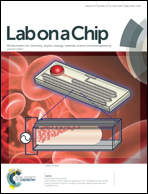Microfluidic investigation of the deposition of asphaltenes in porous media†
Abstract
The deposition of asphaltenes in porous media, an important problem in science and macromolecular engineering, was for the first time investigated in a transparent packed-bed microreactor (μPBR) with online analytics to generate high-throughput information. Residence time distributions of the μPBR before and after loading with ~29 μm quartz particles were measured using inline UV-Vis spectroscopy. Stable packings of quartz particles with porosity of ~40% and permeability of ~500 mD were obtained. The presence of the packing materials reduced dispersion under the same velocity via estimation of dispersion coefficients and the Bodenstein number. Reynolds number was observed to influence the asphaltene deposition mechanism. For larger Reynolds numbers, mechanical entrapment likely resulted in significant pressure drops for less pore volumes injected and less mass of asphaltenes being retained under the same maximum dimensionless pressure drop. The innovation of packed-bed microfluidics for investigations on asphaltene deposition mechanisms could contribute to society by bridging macromolecular science with microsystems.


 Please wait while we load your content...
Please wait while we load your content...